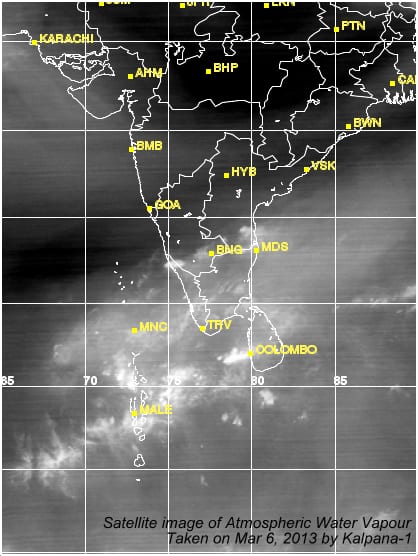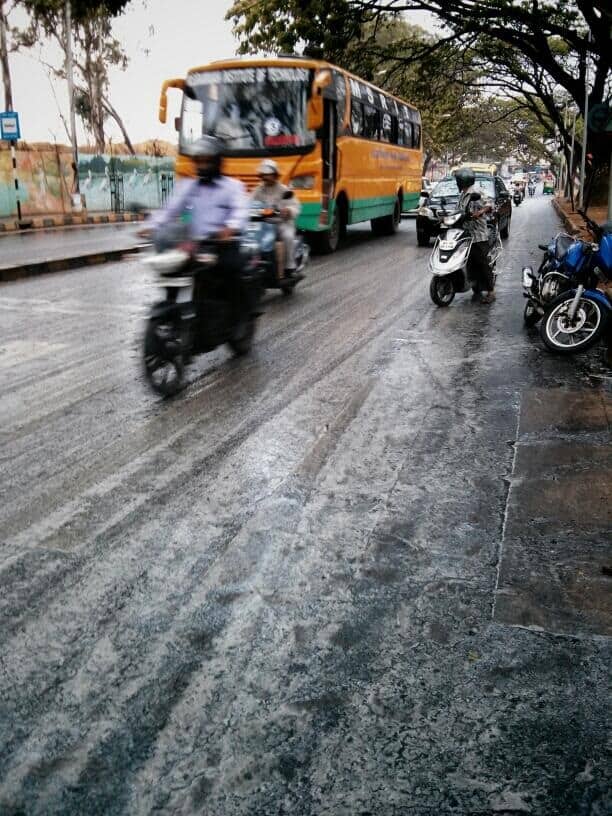The weather in Bengaluru has become rather unusual these past few days – with dark clouds smothering the sky, accompanied by short spells of rainfall across the city. And this after a streak of particularly hot days – which went as high as a daytime maximum of 33.2°C on March 3rd, coming back down to a daytime high of 27.1°C yesterday (6th) under the influence of clouds and spells of rain.
With all apparently unusual weather in the city comes the talk of climate change and how the climate of the city is becoming worse every year. While the city’s climate may indeed be changing, including under the influence of anthropogenic, global climate change, it is important to understand the nuances of Bangalore’s weather, climate and variability first.
Let’s start by asking simple questions in order to place the ongoing weather in the appropriate context. First, how often does it rain in Bangalore in February and March? Second, how much rainfall does the city get when it does rain? And third, what is the nature of this rainfall that the city receives?

As expected, it rains rather rarely in February and March. On any given date in the two months, it has rained for less than 10% of the time in the last 50 odd years. Correspondingly, the average daily rainfall quantities during the period are quite low. However, what is particularly interesting is that if one takes a look at how much rainfall has occurred on any given date in Feb and March when it did rain, the number turns out to be quite high! The adage ‘When it rains, it pours!’ seems to be particularly apt for the months of February and March.
Satellite Map, 6/Mar. Courtesy:IMD
What kind of rain is this, which comes but rarely, but pours a lot when it does? The clue is in the similar pattern one can observe in the latter parts of November and December. It turns out that Bangalore gets its rare winter and pre-summer rainfall from oceanic depressions and cyclones. Rare but intense, the depressions get formed either on the Bay of Bengal or the Arabian Sea and wash over the coasts of Tamil Nadu and Kerala respectively, while Bangalore remains on the fringes of both. The case this year is no different: there is a large depression centered on the Maldives that is driving the weather in South India, with clouds over Bangalore but forming one edge of the system.
Grey foam or Scum on Bangalore roads. Pic: Pavan Srinath
In all, Bangalore occasionally gets off-season rains from oceanic depressions in the months of February and March. While infrequent, they can contribute to significant rains in the city when they do appear. It is easy to claim that Bangalore’s summers are starting early and thus the summer rains are starting early as well, but the evidence for such a case remains weak. Now, will such oceanic depressions over the Indian Ocean become more frequent or more intense due the climate change? The most honest answer one can give today is ‘Maybe’.
Aside: Every year during the first few rains, a white foam or scum can be observed on the roads of the city. This is because the rain water mixes with a few months’ worth of oils, tar and rubber that have accumulated on the roads over the winter. It is possible that they make the roads more slippery than usual. They don’t appear after subsequent rains in the year.⊕


Finally, a more professional explanation than the cliched jargon dished out by the Meteorological dept. Good work Pavan and CM.
This is an interesting piece of study. Can one split the data on average rainfall into say 10 yer intervals and check if the pattern has shifted with time ?the error bars could be big but one may still get some idea of what is happening
Being a Bangalorean i have see rains in Fem and mar months.It may not be huge.this pattern of raining i have noticed from1995 atleast.global warming may be one reason.
My native is Bangalore and have pass thru these rains when temperature reaches 36 degree reach. My childhood, we never experienced such humidity and hot. Even in summer used to get tonsils due to chillness. Imagine how Bengaluru was…..wide footpath, wide footpath, less pollution even though mud roads, no path holes even though mud roads, ground water level was just 3-5 feet, every 4 road joining place had circle with garden, every street had flowers tree,
Bangalore enjoys a pleasant and equable climate throughout the year. The highest temperature recorded was 38.9 °C (102.0 °F) on 22 May 1935 and the lowest was 7.8 °C in 1884.[citation needed] Winter temperatures rarely drop below 11 °C (52 °F) and summer temperatures seldom exceed 36 °C (97 °F.
The good reason to get rainfall during summer due to 350 km from Arabian sea and Bay of Bengal. Mean it’s center of both the sea. when temperature increases water evaporate in parallel western ghat rain forest from tamilnadu kerala, karnataka and Srilanka forest cools down.
Everyone thinks about only Bangalore gets rain, Mysore, Chamarajanagar, Coorg, Dakshina Kannada and Uttara Kannada District gets high ratio, and also rom Srilanka till Karawara and middle part of karnataka gets rain. Some places may get drizzling to heavy rain.
We all wanted to restore the Old Bangalore, reduce pollution, traffic, cement buildings, Plastic free many things. We need to kick off all IT companies from Bangalore to secure Old Bangalore.
My native is Bangalore and have pass thru these rains when temperature reaches 36 degree reach. My childhood, we never experienced such humidity and hot. Even in summer used to get tonsils due to chillness. Imagine how Bengaluru was…..wide footpath, less pollution even though mud roads, no path holes even though mud roads, ground water level was just 3-5 feet, every 4 road joining place had circle with garden, every street had flowers tree,
Bangalore enjoys a pleasant and equable climate throughout the year. The highest temperature recorded was 38.9 °C (102.0 °F) on 22 May 1935 and the lowest was 7.8 °C in 1884.[citation needed] Winter temperatures rarely drop below 11 °C (52 °F) and summer temperatures seldom exceed 36 °C (97 °F.
The good reason to get rainfall during summer due to 350 km from Arabian sea and Bay of Bengal. Mean it’s center place for the both the sea. when temperature increases water evaporate in parallel western ghat rain forest cools down, depression happens and rain gets from tamilnadu kerala, karnataka and Srilanka forest cools down. Everyone thinks about only Bangalore gets rain, Mysore, Chamarajanagar, Coorg, Dakshina Kannada and Uttara Kannada District gets high ratio, and also rom Srilanka till Karawara and middle part of karnataka gets rain.
Some places may get drizzling to heavy rain, but Bangalore gets enough rain to maintain cool temperature.
We all wanted to restore the Old Bangalore, reduce pollution, traffic, cement buildings, Plastic free many things. We need to kick off all IT companies from Bangalore to secure Old Bangalore.
Hi,
I want to know why in bangalore now a days rain is coming regular . Before that it was not coming that much but now its coming daily.